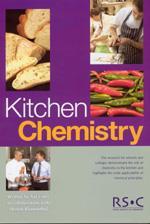Kitchen chemistry
Kitchen chemistry
Ted Lister (in collaboration with Heston Blumenthal)
London, UK: RSC | 2005 | 116pp | ?19.95 (SB and
CD-ROM) | ISBN 0854043896
Reviewed by Elisabeth Hazlewood
Kitchen chemistry is a resource book for school and colleges, from primary school children to post-16 year olds. Although not directly related to any particular part of the school curriculum, this material provides chemistry teachers with a real-life link to the topics they teach and shows youngsters that chemistry is everywhere, including the very important area of the food they eat. For example there is an experiment which looks at enzyme activity using the action of fresh and tinned fruit on setting jelly. Pupils get the experience of fruit jelly that won’t set and they can see a chemical reason for this observation.

The topics covered have been carefully chosen to demonstrate how fundamental principles of chemistry can be understood from examples in the kitchen, while at the same time showing that some of the questions we have about cooking can be answered from chemical considerations.
Additional resources are provided on a CD-ROM which accompanies the book. These resources provide pupils with background information as well as experimental detail, though some would probably need to be adapted for younger/less able pupils. The information on the photocopiable sheets could also be used within other lessons to give some added interest. Within the resources are questions to get pupils to think about what they are doing and to help them interpret their results; answers to these questions are provided throughout. Finally there are links to video clips from the Discovery Channel TV series of the same name, which are available on the RSC’s website.
Health and safety issues relating to each experiment and food-tasting activity are highlighted and guidance is given on how to deal with them.
The age range for which each experiment is suitable is indicated. A lot of the experiments are more suitable for post-16 students and would be particularly useful for vocational students as they can be related to real-life situations, for example the analysis of low sodium salt substitutes.
Overall, this is a good resource for schools and will provide science teachers with new, interesting and useful material to inspire chemistry in the young.












No comments yet